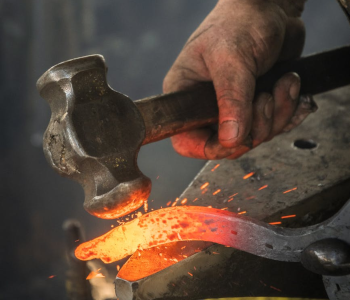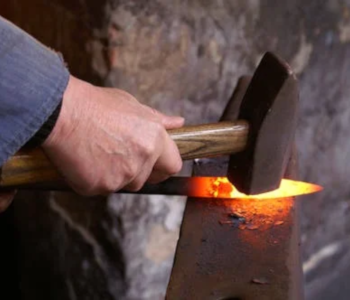Forging: How It Works, Pros and Cons, and Applications
We’ve already written an overview of the various manufacturing processes that have been developed through the years and continue to be practiced to this day. Collectively, these manufacturing processes comprise the techniques that transform raw materials to finished goods that are relevant both commercially and industrially. From household items to steel girders, just about every single object meant for human use has been through a series of manufacturing processes.
In this article, we will be focusing on one of the older processes – forging. What exactly is forging and what are the products of forging that we see in our daily lives?
What is forging?

Forging is a metalworking process in which localized forces are applied to a piece of metal to shape it into the desired form. It is one of the most ancient manufacturing process, dating back to the time of the Mesopotamians in the fertile crescent. If you’ve ever watched a movie where a piece of metal has been heated and pounded by a blacksmith to create a sword, then you know how the forging process works at the fundamental level.
In the olden times, the compressive forces needed for forging were delivered by standard hammers. Nowadays, hammering tools are either electronic or driven by hydraulic or pneumatic fluids.
The use of localized forces makes forging one of the more flexible manufacturing processes. However, it is also the go-to technique when manufacturing parts that need to have high strength. It is a very low-cost process that only requires minimal set-up of the equipment for long production runs.
Forging temperatures
Modern forging techniques may make use of different types of machine assemblies, but they can all be broadly classified into two types – hot and cold forging.
Hot forging
Hot forging is forging as most people know it. The metal piece is heated to above its recrystallization temperature, after which the compressive forces are applied. Heating reduces the yield strength of metals and enhanced ductility, thus reducing the impact forces needed to cause an upset on the structure of the metal. This also translates to a faster process and more precise results.
The need to heat metal pieces to temperatures exceeding 2000 degrees Fahrenheit means having a hot furnace facility. This can be a huge investment for manufacturers and introduces additional hazards to a work environment.
Cold forging
It’s also possible to carry out the forging process at room temperature with the cold forging technique. There’s also a variation called warm forging where the metal is heated but only to a point below its recrystallization temperature.
By skipping the heating part, cold forging can process parts with better dimensional control and uniformity of mechanical properties. However, the lack of ductility also means that higher compressive forces will be necessary. Cold forged parts are prone to exhibit the phenomenon of work hardening, or the change in physical properties due to the application of compressive forces. Thus, cold forging becomes increasingly more difficult as the processing of a part progresses.
Not all metals can be processed via cold forging. Particularly hard metals, like iron and steel, will always have to be heated before forging.
How does it work?
The main reason why parts are made through forging is the superior strength that the process provides. This happens through the deformation of the internal grain texture. As compressive forces are applied to the metal, its grains deform and align to the general shape to which the part is being forged. This alignment of grain structure is something that manufacturers can take advantage of when designing parts with desired directional strength.
Better mechanical properties are also achieved by the removal of voids and the reduction of gas porosity.
Types of forging processes
Drop forging
In drop forging, the compressive forces are applied by the sudden “dropping” of a hammer onto the workpiece. This is a rapid process that can be used for specific parts of a single workpiece, allowing for a greater degree of customization. However, it is also a technique that lacks control. In some cases, secondary shaping processes are done after the drop forging step.
To attain the desired shape in drop forging, the part is pressed against a pre-formed die. This can be either an open die, where the part is simply placed on top of an anvil or a closed die, where the metal will take the shape of an impression. Closed-die forging is appropriate for the manufacture of strong and highly precise parts. Open die forging is typically done to create ingots or parts for low-volume production.
Press forging

In press forging, compressive forces are applied via a continuous and sustained application of pressure. A die is almost always used in press forging to deform a metal into the desired shape. By distributing the force to a longer application period, the operator can better control the mechanical properties of the finished part. The compressive forces are also applied more uniformly, resulting in a part with more consistent characteristics.
Roll forging process
Roll forging is a special forging process used to create long metal strips or wires. It works by feeding metal bars between two cylindrical rolls that apply continuous pressure as they rotate. The metal bars are almost always pre-heated to make them ductile enough to deform under relatively smaller compressive forces. Parts made via roll forging have an exceptionally uniform grain structure.
Pros and cons of forging
Despite being an ancient technique, forging is still around and remains industrially relevant. However, it’s not an all-encompassing option for metalworking, with more advanced options like molding and casting taking away some of the limelight. What makes forging work and what are its limitations?
PROS
Exceptional strength
The primary driving force to use forging as a manufacturing technique is to create parts with superior strength. The retention of a metal’s grain structure and its controlled alignment is something that can only be achieved through forging. It also avoids the potential uptake of contaminants which can happen whenever a metal is melted and solidified.
High production rates
It may take some time to set up equipment for forging, but it’s a very fast process once everything has been put in place. The reliance of forging on quick applications of extreme stress means that parts can go through the forging step in a matter of seconds. This isn’t true for hot forging, of course – you’re going to need several minutes to heat up a metal part to the suitable temperature. However, forging technology can still be seamlessly integrated into an existing manufacturing process with proper planning.
Low chances of rework or scrap
The simplicity of forging means that the process suffers less downtime and has fewer rejects compared to molding or casting. The need to rework or scrap rejected products is a natural part of any manufacturing process and one that comes at a significant cost. By choosing forging over other manufacturing processes, a facility can save on significant time and money spent on handling scrapped products.
CONS
High capital costs
A lot of heavy machinery goes into a forging process. At the bare minimum, you will need hammers and presses capable of delivering pressure to deform metals. These pieces of equipment are large, powerful, and very expensive. If you need to do hot forging to deal with hard metals, you will need to have heating furnaces large enough to fit the parts you will be working on.
If dies will be used in the forging process, then they would have to be precisely engineered and heat-treated. These also represent significant startup costs.
High energy costs
Aside from the high capital costs, the costs of operating a forging process are also relatively high. A tremendous amount of power is needed to drive drop hammer to deform metals, although the costs can be staved off by using hydraulic or pneumatic fluids. Significant energy is also needed to heat up metals to their recrystallization temperatures – this can go up to anywhere between 2000 to 3000 degrees Fahrenheit.
Despite the high operational costs of forging, it is still considered a more economical alternative to casting or molding. This is because of the higher reliability of forging that greatly reduces the need to rework finished pieces or the occurrence of scraps.
Applications of forging
With decades of practice and widespread industrial use, coming up with a list of applications of the forging process is a near-impossible task. Forged components run the gamut from hand tools and pipeline fittings to agricultural machinery and aerospace components.
The characteristic strength and reliability of forged components make them excellent options for heavy-duty applications. Thus, forging is commonly used to manufacture the axle beams, transmission shafts and gears, driveshafts, wheel spindles, ball studs, differential gears, and steering arms of automobiles. In oil fields and utilities, the pipes, valves, flanges, and other fittings are commonly manufactured via forging.
What we’ve listed here is but a fraction of all the possible applications of forging. If there’s an industry that relies on parts that will perform at a high level of reliability, then there’s a good chance that you will find forged components in that setting.
Final thoughts
Forging is an ancient manufacturing technique. It is a testament to its long-lasting value that it remains a relevant process even in today’s modern industrial era. Until now, no other manufacturing process can rival a forged component’s level of strength and the relative simplicity of the process. There may be a huge startup cost to set up the equipment needed for forging, but it remains one of the most reliable and economical options for manufacturing industries.

